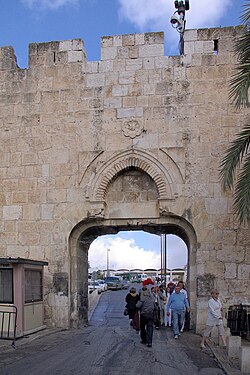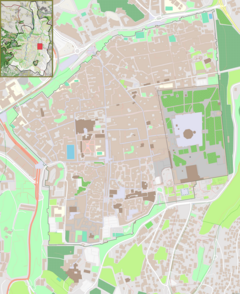This is an old revision of this page, as edited by Hertz1888 (talk | contribs) at 23:14, 17 July 2014 (Reverted 2 edits by Ashrafsayadi (talk): English preferred; also restoring reference to quarter. (TW)). The present address (URL) is a permanent link to this revision, which may differ significantly from the current revision.
Revision as of 23:14, 17 July 2014 by Hertz1888 (talk | contribs) (Reverted 2 edits by Ashrafsayadi (talk): English preferred; also restoring reference to quarter. (TW))(diff) ← Previous revision | Latest revision (diff) | Newer revision → (diff)| Dung Gate | |
|---|---|
 Dung Gate Dung Gate | |
 | |
| General information | |
| Town or city | Jerusalem |

The Dung Gate (also known as, Template:Lang-he-n Sha'ar Ha'ashpot, Gate of Silwan, Moroccan Gate, Template:Lang-ar) is one of the gates in the walls of the Old City of Jerusalem.
The gate is situated near the southeast corner of the old city, southwest of the Temple Mount.
The gate is the closest to the Western Wall and is a main passage for vehicles. It was originally much smaller, but was enlarged in 1952, after the Old City came under Jordanian control in 1948. After its capture by Israel in 1967, architect Shlomo Aronson was commissioned to renovate this gate. Directly behind the gate lies the entrance to the Western Wall compound.
Name
The name Sha'ar Ha'ashpot appears in the Book of Nehemiah:3:13-14. It is probably named after the residue that was taken from the Jewish Temple into the Valley of Hinnom, where it was burned. This ancient "Dung Gate" may not have been in the same location as the modern gate.
The name Moroccan gate (Bab al-Magharibeh) refers to the Moroccan Quarter, no longer in existence, which was situated near the area.
References
- Shlomo Aronson. "Landscape Selected Projects List by Shlomo Aronson". Archived from the original on 2008-04-27. Retrieved 2008-06-13.
External links
31°46′29″N 35°14′2″E / 31.77472°N 35.23389°E / 31.77472; 35.23389
This Israel-related article is a stub. You can help Misplaced Pages by expanding it. |
This geography of Israel article is a stub. You can help Misplaced Pages by expanding it. |
